Found along the Rocky Mountains, the U.S. state of Wyoming is home to beautiful and dynamic landscapes and wildlife. From deserts and plains to mountains and forests, Wyoming features an assortment of landscapes and enjoys all four seasons in a very distinct way. It is also home to some pretty cool cacti, not only in its deserts, but even high up in the mountains. Let’s take a look at some of the incredible cacti that grow wild in Wyoming!
Nylon Hedgehog Cactus (Echinocereus viridiflorus)
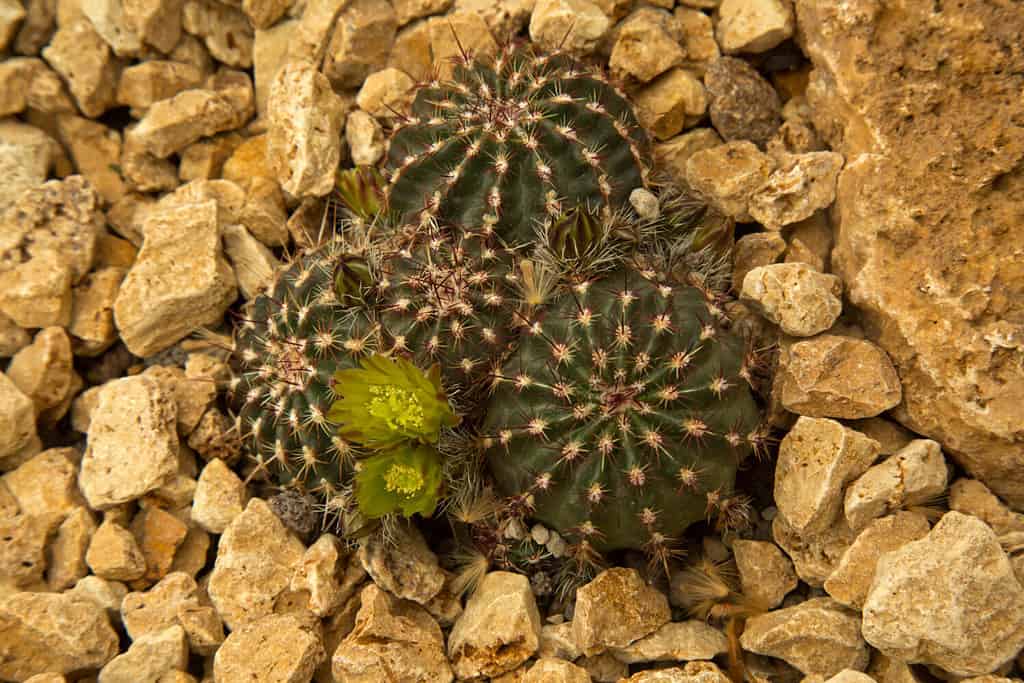
Nylon
hedgehog
cacti grow in grasslands, woodlands, prairies, and desert scrub.
©Podolnaya Elena/Shutterstock.com
The nylon hedgehog cactus is native to the central United States and northern Mexico. In Wyoming, it typically grows up to 12 inches tall in the southeastern corner of the state. These cute cacti grow alone or in small groups of up to 12 plants, each with tiny spines that come in many different colors. The nylon hedgehog cactus also produces 1-inch-long yellow, light green, or light brown flowers.
Brittle Prickly Pear (Opuntia fragilis)
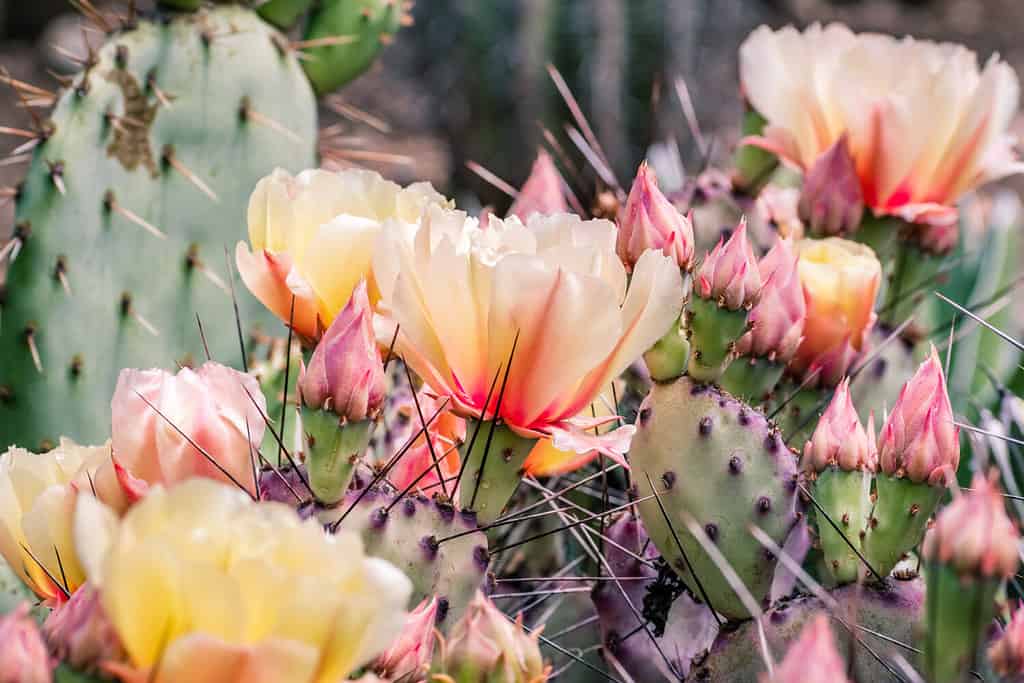
In some states, brittle prickly pears are protected, threatened, and endangered.
©Sundry Photography/Shutterstock.com
The brittle prickly pear (or little prickly pear) is native to western regions of North America. It is a small cactus that grows in small clusters or clumps that are rarely more than 4 inches tall. A group of brittle prickly pears can measure more than 12 inches wide, each equipped with barbed spines up to 1 inch long. It gets its name from its “brittle” cactus pads, which are connected to the plant rather loosely and break off easily when animals pass by. Brittle prickly pears grow in deserts, woodlands, grasslands, and scrublands, often alongside bunchgrass and sagebrush.
Great Plains Prickly Pear (Opuntia polyacantha)
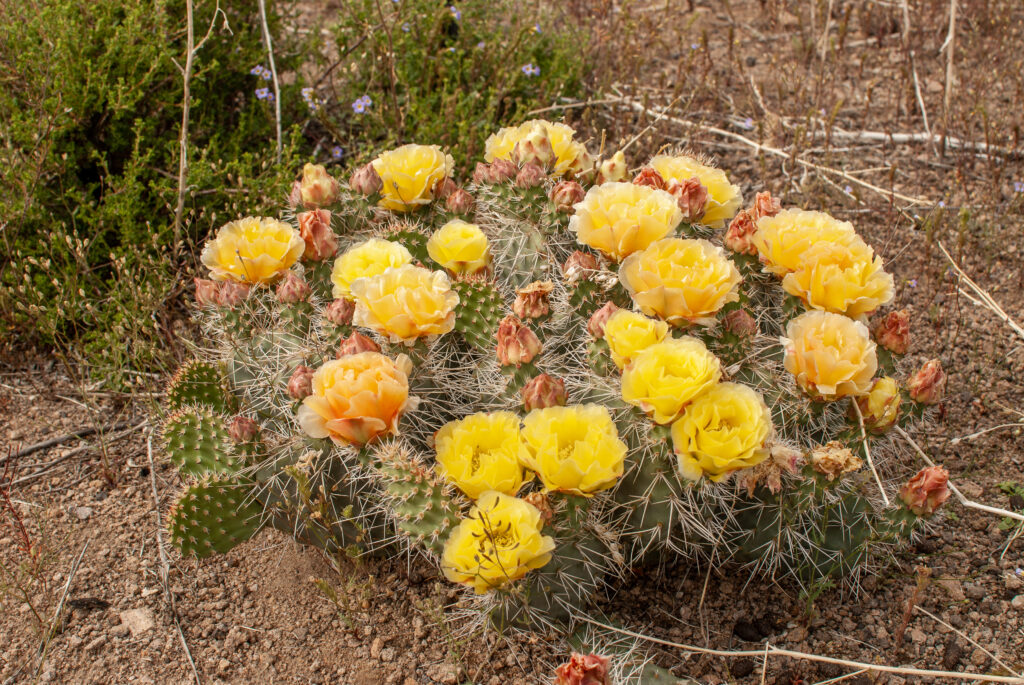
The spines of Great Plains prickly pear cacti can be straight, short, long, or even curly.
©Dominic Gentilcore PhD/Shutterstock.com
Reaching 4 to 12 inches tall, the Great Plains prickly pear grows throughout much of the western United States, including Wyoming. Although it grows quite low to the ground, a cluster of Great Plains prickly pears can reach lengths of 6 to 9 feet! These cacti have flat, rounded pads that look a bit like prickly green pancakes. Each pad is covered with tiny, hair-like projections, in addition to larger spines. The Great Plains prickly pear produces lovely flowers in shades of yellow or pink, which later transform into spiky brown fruits. It is a tough cactus that can survive cold winters and hot summers.
Plains Prickly Pear Cactus (Opuntia cymochila)
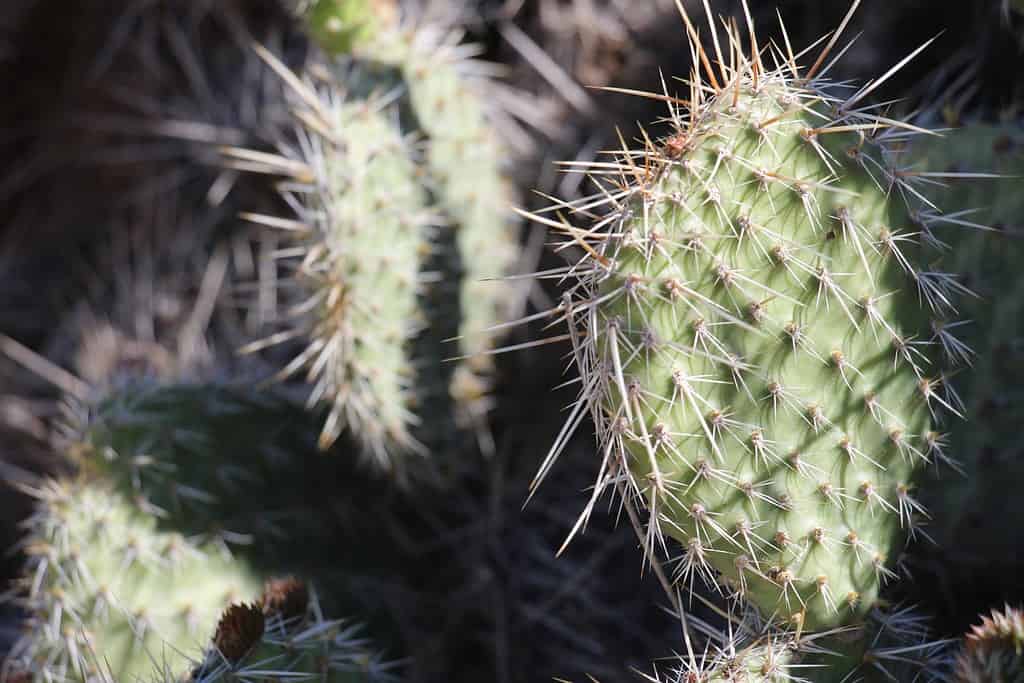
The plains prickly pear produces purple-red oval-shaped fruits following its blossoms.
©Gabe Shakour/Shutterstock.com
Growing across the Great Plains in the United States, the plains prickly pear is slightly larger, reaching around 16 inches tall. In addition, its flat pads are tightly connected and do not break off easily like many other cacti. The pads are smooth, with an oval or teardrop shape. They have rows of areoles (which look kind of like warts), with spines and little hairs growing out of them. The plains prickly pear cactus produces beautiful yellow and golden flowers with a red center, typically 1 to 2.5 inches wide.
5. Spiny Star (Escobaria vivipara)
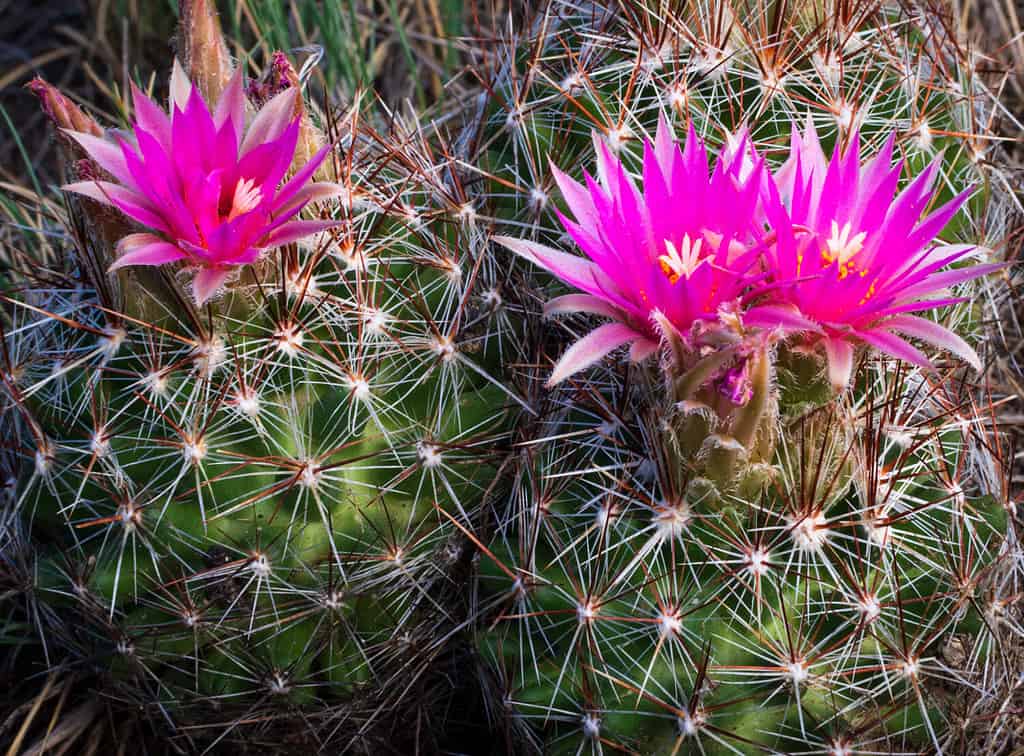
Spiny star cacti can grow alone or in tight clusters.
©BT Images/Shutterstock.com
Also known as the pincushion or common beehive cactus, the spiny star grows in eastern regions of Wyoming, the west and central United States, Mexico, and Canada. Spiny star cacti have many bumps along their surface, each sprouting both short and long spines that each point in a different direction. These overlapping spines often make the cacti appear hairy or like they are wrapped in spider webs. Spiny star cacti produce beautiful pink flowers that bloom in spring or summer, followed by green fruits.
Twist-Spine Prickly Pear (Opuntia macrorhiza)
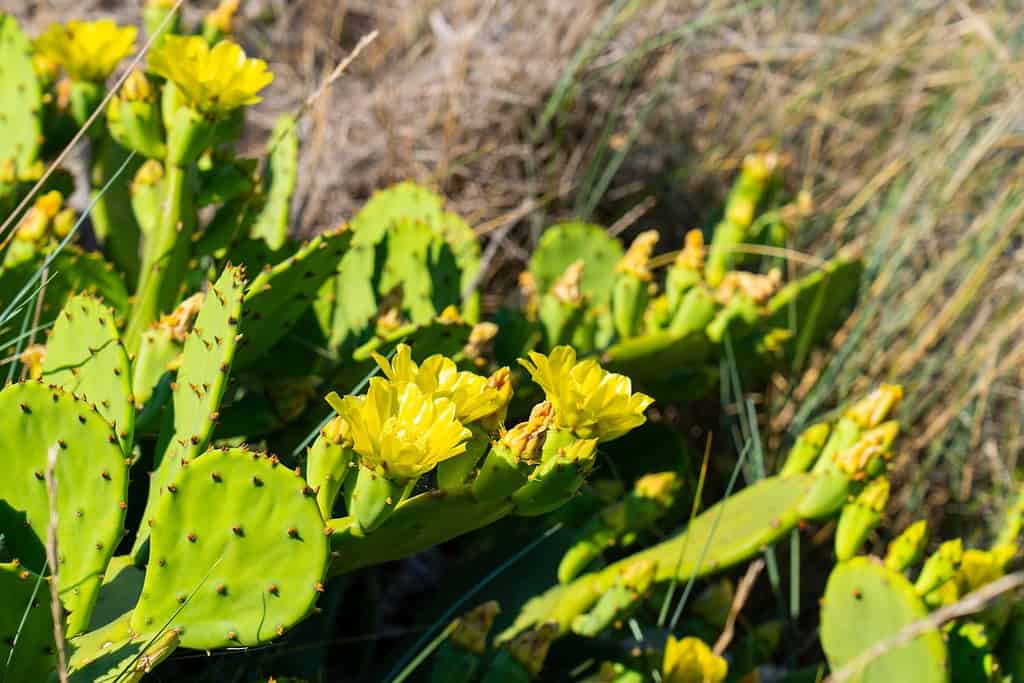
The twist-spine prickly pear is easy to confuse with the devil’s tongue or eastern prickly pear.
©martin.dlugo/Shutterstock.com
The twist-spine prickly pear is a low-growing cactus with greenish-blue pads. It often grows together with other cacti in large clumps that can measure several feet across. Twist-spine prickly pears produce yellow or orange flowers with red centers. They may look pretty, but don’t touch them!! Twist-spine prickly pear cacti have tiny needles called glochids that love to stick to your skin. They are nearly invisible and can be very annoying and itchy.
Missouri Foxtail Cactus (Escobaria missouriensis)
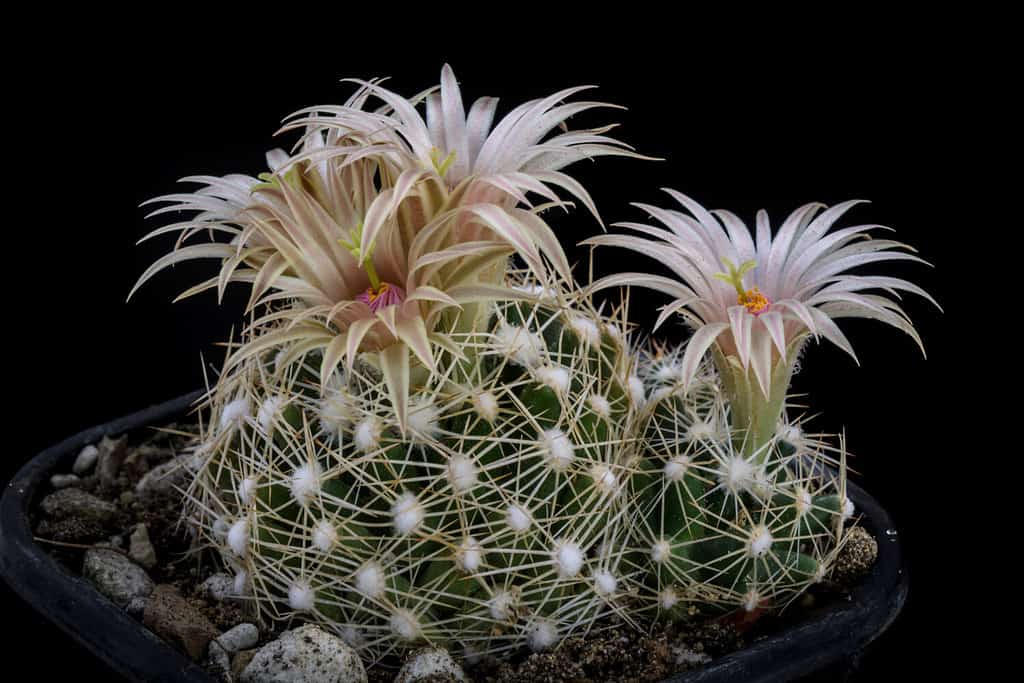
Merriweather Lewis recorded the Missouri foxtail cactus back in 1805.
©Cpifbg13/Shutterstock.com
Although it’s named after a different state, the Missouri foxtail cactus also grows in the wilds of Wyoming! This showy cactus can reach up to 12 inches tall and forms 1- to 12-inch-wide clumps. It produces yellow or pink blossoms in the late spring or early summer. It grows low to the ground with an extensive root system that allows it to thrive along rocky slopes or in dry grasslands.
Mountain Ball Cactus (Pediocactus simpsonii)

The mountain ball cactus is sometimes referred to as Simpson’s hedgehog cactus.
©Danita Delimont/Shutterstock.com
The mountain ball cactus is different than others in Wyoming because it lives high up in the mountains. It is often found at elevations of 4,600 feet up to 11,500 feet! Mountain ball cacti are pretty rare, although if you’re lucky, you might spot on at higher elevations in western and southern Wyoming. These hardy cacti have a perfectly round shape and grow up to 6 inches in diameter with stiff spines. They also produce bright pink, white, magenta, yellow, or yellow-green flowers from early May to June.
The photo featured at the top of this post is © martin.dlugo/Shutterstock.com
Thank you for reading! Have some feedback for us? Contact the AZ Animals editorial team.







